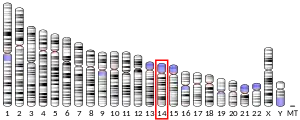| RTL1 | |||||||||||||||||||||||||||||||||||||||||||||||||||
|---|---|---|---|---|---|---|---|---|---|---|---|---|---|---|---|---|---|---|---|---|---|---|---|---|---|---|---|---|---|---|---|---|---|---|---|---|---|---|---|---|---|---|---|---|---|---|---|---|---|---|---|
| Identifiers | |||||||||||||||||||||||||||||||||||||||||||||||||||
| Aliases | RTL1, MART1, Mar1, PEG11, retrotransposon-like 1, retrotransposon Gag like 1, SIRH2, HUR1 | ||||||||||||||||||||||||||||||||||||||||||||||||||
| External IDs | OMIM: 611896 MGI: 2656842 HomoloGene: 120261 GeneCards: RTL1 | ||||||||||||||||||||||||||||||||||||||||||||||||||
| |||||||||||||||||||||||||||||||||||||||||||||||||||
| |||||||||||||||||||||||||||||||||||||||||||||||||||
| |||||||||||||||||||||||||||||||||||||||||||||||||||
| |||||||||||||||||||||||||||||||||||||||||||||||||||
| Wikidata | |||||||||||||||||||||||||||||||||||||||||||||||||||
| |||||||||||||||||||||||||||||||||||||||||||||||||||
RTL1 (retrotransposon like 1) is a retrotransposon derived protein coding gene.[5] It is also known as PEG11 and is a paternally expressed imprinted gene, part of genomic imprinting. RTL1 plays an important role in the maintenance of fetal capillaries and is expressed in high quantities during late stage of fetal development.[5] The expression of this gene is important for the development of the placenta, the fetus-maternal interface. Because the placenta is the first organ to form during the development of an embryo, problems in its establishment and biological role lead to complications during gestation.[6] This organ maintains the fetus throughout the pregnancy and is therefore sensitive to disruptions. Studies in mice suggest that disruption of the RTL1 concentration, whether increasing or decreasing the amount of this protein coding gene, can lead to serious errors in the conservation of placental fetal capillaries. RTL1 knockout mice have shown obstruction in fetal development along with late fetal/neonatal death.[7] Studies from sheep homologs suggest that high expression levels of RTL1 can lead to skeletal muscle hypertrophy This is due to over-expression patterns in the paternal allele specific gene.[8]
References
- 1 2 3 GRCh38: Ensembl release 89: ENSG00000254656 - Ensembl, May 2017
- 1 2 3 GRCm38: Ensembl release 89: ENSMUSG00000085925 - Ensembl, May 2017
- ↑ "Human PubMed Reference:". National Center for Biotechnology Information, U.S. National Library of Medicine.
- ↑ "Mouse PubMed Reference:". National Center for Biotechnology Information, U.S. National Library of Medicine.
- 1 2 Sekita Y, Wagatsuma H, Nakamura K, Ono R, Kagami M, Wakisaka N, et al. (February 2008). "Role of retrotransposon-derived imprinted gene, Rtl1, in the feto-maternal interface of mouse placenta". Nature Genetics. 40 (2): 243–8. doi:10.1038/ng.2007.51. PMID 18176565. S2CID 5455176.
- ↑ Rossant J, Cross JC (July 2001). "Placental development: lessons from mouse mutants". Nature Reviews. Genetics. 2 (7): 538–48. doi:10.1038/35080570. PMID 11433360. S2CID 28327869.
- ↑ Kitazawa M, Tamura M, Kaneko-Ishino T, Ishino F (February 2017). "Severe damage to the placental fetal capillary network causes mid- to late fetal lethality and reduction in placental size in Peg11/Rtl1 KO mice". Genes to Cells. 22 (2): 174–188. doi:10.1111/gtc.12465. PMID 28111885.
- ↑ Bidwell CA, Kramer LN, Perkins AC, Hadfield TS, Moody DE, Cockett NE (August 2004). "Expression of PEG11 and PEG11AS transcripts in normal and callipyge sheep". BMC Biology. 2: 17. doi:10.1186/1741-7007-2-17. PMC 514575. PMID 15298706.



